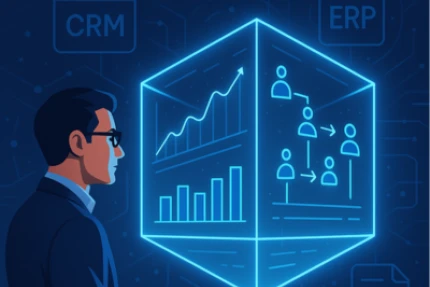
We recently sat down with Discern’s Chief Data Scientist, Ling Lin. During the discussion, we learned more about her work automating ARR calculations for some of the fastest growing SaaS companies. Below is a transcript of the conversation, providing insights into how companies can accurately calculate ARR.
What led you to become cofounder and Chief Data Scientist at Discern?
I began my career in the financial services industry, which is very data heavy. During my tenure at Citi, my team and I built Yield Book, a fixed-income analytics service and related indexing business. Today Yield Book is now part of the London Stock Exchange. As I transitioned from financial services into the software space, I continued to specialize in leading data analytics efforts.
Throughout this experience, I’ve always had an interest in AI, much before its modern popularity. Having worked previously with my co-founder, Helen Lin, we came together and discussed the potential AI could have on BI. Understanding that most data at our fingertips goes underutilized due to volume and accessibility, we knew the value of AI. This conversation eventually led us to start Discern. Today we utilize data analytics and AI methods to uncover the most important performance trends across a SaaS organization.
A big part of your role at Discern is helping customers calculate ARR. Why is Recurring Revenue such an important metric for SaaS businesses?
Over the last 20 years, we witnessed the software industry shift from the traditional model of perpetual licenses to the SaaS model. With the advent of SaaS, we’ve transitioned from a buy-and-install economy to a subscription-based one. In this subscription economy, the initial revenue generated from software is lower, as users pay on a recurring basis (often annual) rather than upfront. This shift in revenue structure places greater emphasis on metrics like Annual Recurring Revenue.
Without a clear understanding of annual recurring revenue, other key metrics cannot be calculated.
Ling Lin, Chief Data Scientist, Discern
For SaaS companies, being able to calculate ARR is crucial. Annual Recurring Revenue provides a clear picture of how much predictable revenue a company can rely on, offering insights into the sustainability and growth potential of the business. Additionally, investors and stakeholders often look at recurring revenue as a leading indicator of the company’s revenues, making it a fundamental SaaS metric for valuing companies.
Finally, Annual Recurring Revenue serves as the foundation for several other critical SaaS metrics, such as GRR, NRR, ARR Growth Rate, and Gross Logo Retention. Without a clear understanding of annual recurring revenue, these other metrics (which investors also emphasize) cannot be calculated.
Given your work with SaaS companies, how do most businesses calculate ARR today?
Unlike traditional financial metrics that change only on a monthly basis after closing, annual recurring revenue is a point-in-time metric that undergoes daily fluctuations. It encompasses the entirety of operational aspects within a business, providing a real-time snapshot of recurring revenue. As a result, each company must decide how often they want to calculate ARR.
Most companies we work with used to manually calculate ARR, which means daily ARR calculations are unrealistic. As a result, we see many companies calculate ARR on a monthly or quarterly basis.
When I say companies are “manually calculating ARR”, I mean that they are tracking ARR in spreadsheets by each of their customer accounts. Or, they manage a manual ARR field in their CRM. Managing ARR by account involves tracking key data points for each customer, including the contract start dates and end dates, renewals, upgrade or downgrade events, cross-sells, and the associated billing. For companies with hundreds to hundreds of thousands of customers, this can get quite messy.
Companies can automate ARR calculations daily utilizing a tool like Discern.
Why is it so difficult for SaaS companies to calculate ARR and what are some of the most common ARR errors you see?
Because there are multiple objects that can house ARR data, companies need to define their system of record and tie the information together for reconciliation purposes.
Ling Lin, Chief Data Scientist, Discern
The most common issue behind inaccurate ARR calculations is simply human error. Someone fat fingering a subscription start or end date can mess up ARR calculations very easily.
Additionally, because there are multiple objects that can house ARR data – Opportunities, Contracts, and Invoices, companies need to define their system of record and tie the information together for reconciliation purposes – which is not an easy thing to do given that these objects can live in multiple systems – the CRM, Invoice System, etc. Since most companies are not able to digitally connect this information, it’s nearly impossible to spot and correct issues in the ARR calculations without days or weeks of manual reconciliation work.
Furthermore, account hierarchies in the CRM can complicate ARR calculations. For example, a new logo acquired at account level is an upsell at the parent account level. It is difficult to track these two different ways of looking at customer retention – at the child account level versus at the parent account level – manually.
Finally, every company needs to define rules for how to treat various retention scenarios. Common scenarios include how to treat customers you churn but win back within a certain time frame or when to consider a customer churned versus just a late renewal. Now, when a company changes these rule definitions, it is very difficult to go back and update the historical data – namely because the reference data required was not captured (such as how many days late did the account renew).
Considering all these complexities, how does Discern calculate ARR?
When we implement a new company, we define and set up programmatic rules for various recurring revenue change scenarios.
From there, we can run the ARR calculation and identify the potential breakage points. We advise the companies on where to update their data quality such that data from multiple systems are linked.
Is there anything that makes Discern’s ARR calculations particularly unique or interesting?
Discern milestones the data so customers can calculate ARR at previous points in time versus what is it going forward to account for changes. Basically, we provide customers with multiple versions of their ARR calculation. For example, let’s say last quarter a company considered an account a late renewal, but in this quarter, we realize that that customer actually churned. Now, the Recurring Revenue total that was reported last quarter is actually higher than what it truly was. Discern can show you that point in time snapshot versus the current annual recurring revenue for last quarter.
Discern can also break down ARR calculations and retention rates by any segment. This allows customers to easily slice and dice by things like region, industry, or product.
Additionally, Discern provides a unique cohort analysis for Recurring Revenue, GRR, and NRR. Discern groups customers based on their vintage and can reveal how Recurring Revenue and retention rates evolve over time. Customers find this particularly helpful when measuring the impact of customer success initiatives.
Lastly, Discern not only calculates last-twelve month Net Retention Rate by account but also predicts each account’s next-twelve month NRR. This helps customer success teams manage their accounts.
Click here to add Ling on LinkedIn.



